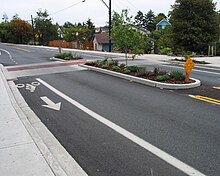Traffic island
Traffic islands (also called lane dividers or central islands ) are demarcated areas in the lane that are generally not allowed to be driven on. They can be designed differently depending on the purpose. The rounded beginning and end of a traffic island is called the island head . At roundabouts one speaks of central islands .
Many traffic islands are elevated and have curbs on their edges. On many traffic islands there are traffic signs (e.g. the sign 222-20 "right over") and a red and white striped board, e.g. B. the hatched beacon . On some traffic islands there are plant troughs or street lamps (e.g. to illuminate a crossing).
Traffic islands mainly serve:
- to separate traffic flows in opposite directions at dangerous spots such as junctions or junctions . Their separating and protective effect goes beyond that of restricted areas .
- the easier crossing of the road . These crossing systems (jumping islands) are usually attached to pedestrian crossings and divide the roadway. Traffic islands allow pedestrians to stop; you can cross the road “in two stages”.
- at town entrances to reduce speed. The lane leading into the town is usually pivoted a little.
- As a stop island with the function of a platform for the tram or bus platform , to enable safe boarding and alighting, sometimes even at the same height .
The "Guidelines for the creation of nodes" ( RAS-K ) differentiate between the following island forms:
- Road divider outside urban areas (large and small island of drops)
- Urban lane divider
- Triangle island
Structurally, the islands are always raised. Inclined curbs have some advantages compared to conventional curbs:
- they can be run over by trucks or buses in exceptional cases.
- If a vehicle accidentally hits a conventional curb, the tire could be damaged; track and fall are often misaligned (both are invisible damage; they can later lead to serious accidents); the vehicle can the spin fall
If they are used by pedestrians, an asphalt or pavement is usually also applied. Some traffic island areas are "open at the bottom": rainwater can seep downwards.



